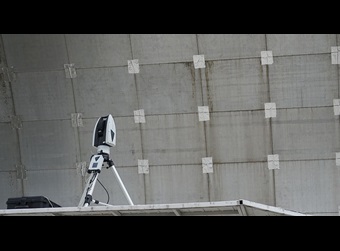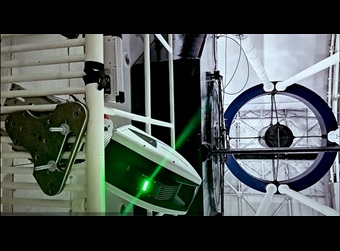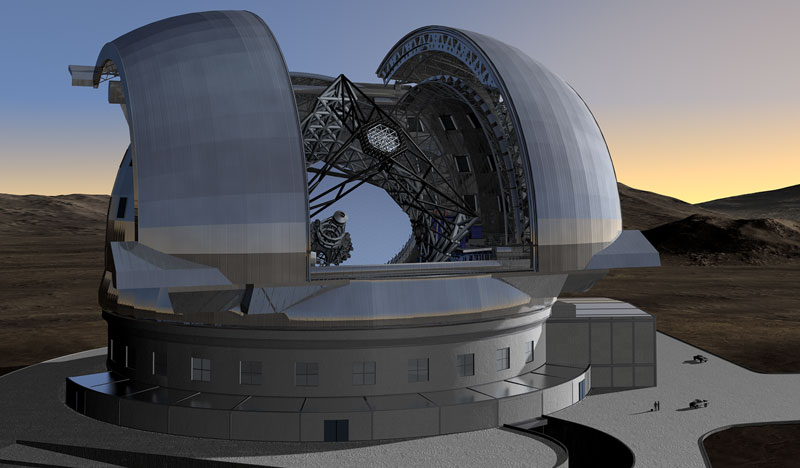Positional correction of a high-altitude optical telescope
Advanced laser tracker direct scanning technology and tilt-mounting capability provides the perfect solution telescope alignment
Contact us
ATS600: Positional correction of a high-altitude radio telescope
The Large Azimuthal Telescope (BTA) is an optical telescope with a main monolithic mirror diameter of 6 metres, the largest in Eurasia. This reflector-type telescope is installed in the Special Astrophysical Observatory (SAO) in Karachay-Cherkessia (Nizhny Arkhyz village, Zelenchuksky district), at an altitude of 2070 metres.
In order to carry out high-quality observations and astrophysical research, the stability of the position of the mirror system elements and the parameters of the geometry of the BTA as a whole must be ensured. Given that the real telescope system (altitude axis, vertical axis, sighting axis of the tube, etc.) does not coincide with the ideal system in which the software is set, there are various kinds of errors of tracking and pointing.
 Modern developments in instrumentation and methods of metrological control open up great opportunities to determine the current state of objects of astrophysical observatories and telescopes. Instruments that allow the determination of spatial coordinates of points of an object under study, based on laser technology, have long been used for spatial positioning and geometric monitoring. Moreover, such systems are incorporated into existing control systems, allowing for real-time correction of the position of work items.
Modern developments in instrumentation and methods of metrological control open up great opportunities to determine the current state of objects of astrophysical observatories and telescopes. Instruments that allow the determination of spatial coordinates of points of an object under study, based on laser technology, have long been used for spatial positioning and geometric monitoring. Moreover, such systems are incorporated into existing control systems, allowing for real-time correction of the position of work items.
 With regard to the applicability of such technology to the BTA, it allows for the continuous geometric control of deformations of various elements of the telescope mirror system. The position of elements of the optical system of the primary focus can be controlled, including displacement of the primary focus glass and the convex hyperbolic mirror. Deformations of telescope tube structures, such as booms, supports and extensions, can also be monitored. Thermal deformations are also able to be tracked, using analysis of telescope tube structures when the tower roof is open and closed as well as during observations. Similarly, weight deformations can be followed through the changing of positions of elements of the mirror system during tube tilting on the full range of angles.
With regard to the applicability of such technology to the BTA, it allows for the continuous geometric control of deformations of various elements of the telescope mirror system. The position of elements of the optical system of the primary focus can be controlled, including displacement of the primary focus glass and the convex hyperbolic mirror. Deformations of telescope tube structures, such as booms, supports and extensions, can also be monitored. Thermal deformations are also able to be tracked, using analysis of telescope tube structures when the tower roof is open and closed as well as during observations. Similarly, weight deformations can be followed through the changing of positions of elements of the mirror system during tube tilting on the full range of angles.
Specialists from Promgeodesiya Ltd carried out measurements to determine the shifts of the primary focus cup relative to the main mirror, depending on the angle of inclination of the tube. During the measurements, the telescope tube was tilted by angles of zenith and azimuth with a certain step.
 The measurements were carried out with a Leica Absolute Tracker ATS600 direct scanning laser tracker. For optimum measurement accuracy, the tracker was securely attached to the telescope‘s midpoint. The tracker‘s orientation was also important – it must be pointed at the primary focus, which requires the tracker to be tilted at an angle of 90 degrees relative to the vertical. Using specialised hardware and the capabilities of the ATS600 laser tracker, it was attached to the mid-mount structures with a tiltable instrument table.
The measurements were carried out with a Leica Absolute Tracker ATS600 direct scanning laser tracker. For optimum measurement accuracy, the tracker was securely attached to the telescope‘s midpoint. The tracker‘s orientation was also important – it must be pointed at the primary focus, which requires the tracker to be tilted at an angle of 90 degrees relative to the vertical. Using specialised hardware and the capabilities of the ATS600 laser tracker, it was attached to the mid-mount structures with a tiltable instrument table.
A Leica NIVEL220 inclinometer was used in conjunction to determine the inclination of the telescope‘s azimuthal axis throughout the measurements.

